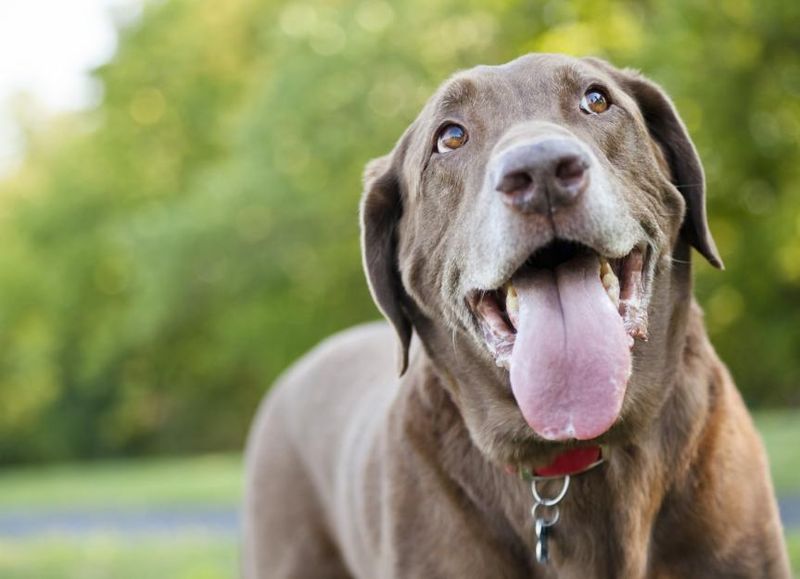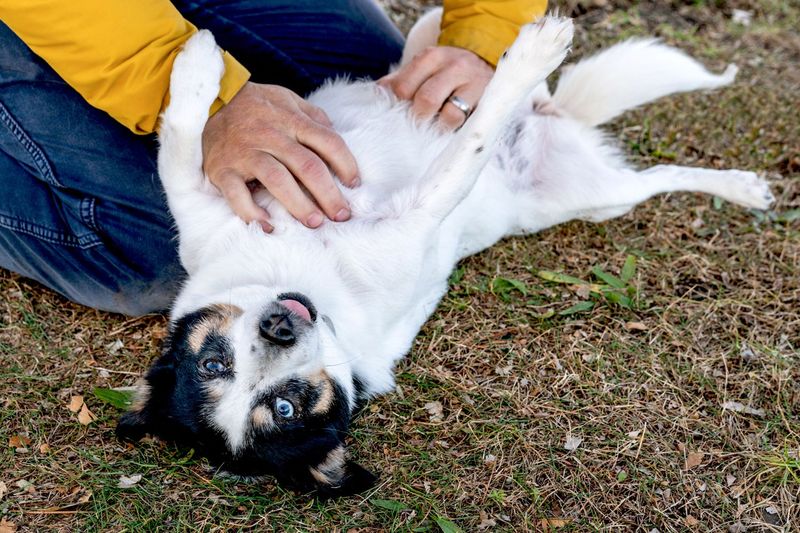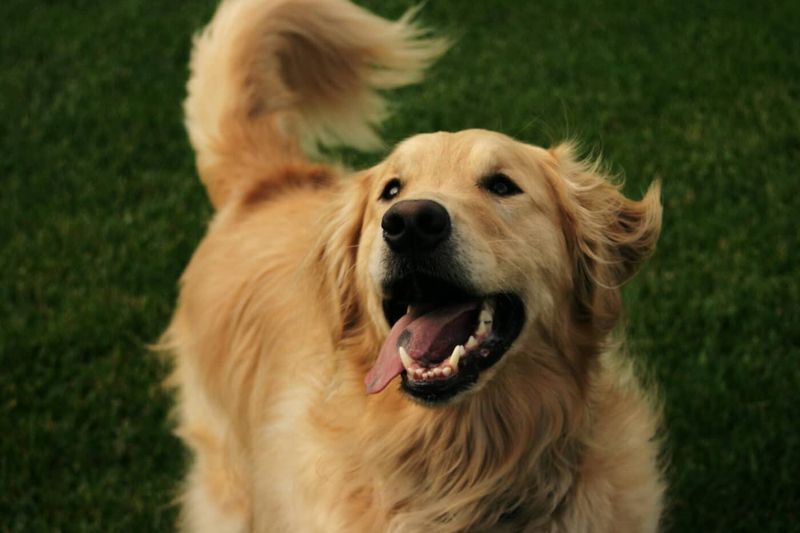Understanding your dog’s emotional signals is key to ensuring their well-being. Dogs express stress, loneliness, and joy through subtle behaviors and signals. By learning to recognize these signals, you can respond appropriately to your dog’s emotional needs and strengthen your bond with them.
Whimpering and Whining
Whimpering and whining are classic signs that a dog is stressed or lonely. These vocalizations can indicate the need for attention or comfort. Often, a dog might whimper when they feel isolated or anxious.
Dogs may whine when left alone or when they miss their owners. This behavior is a call for companionship or reassurance. Understanding this signal can help address your pet’s emotional distress.
Offering gentle words or a comforting presence can often ease this stress. Recognizing when a dog is genuinely distressed can make a big difference in their emotional health.
Tail Wagging
A wagging tail might seem straightforward, but its meaning can vary. A wide, sweeping wag usually indicates happiness and excitement.
In contrast, a slow, low wag might suggest uncertainty or nervousness. By observing the tail’s position and motion, you can better gauge your dog’s emotional state.
Happy wags often accompany playtime or greeting beloved humans. Understanding this signal helps in creating joyful interactions. Differentiating between types of wags ensures you’re attuned to your dog’s feelings.
Ears Perked Up
When a dog’s ears are perked up, it often signals curiosity or interest. This posture shows they’re attentive to surrounding sounds or sights.
Dogs will usually perk up their ears when they hear unfamiliar noises or when something catches their attention. This can be a sign of joy or excitement in exploring new things.
Recognizing this signal fosters a better understanding of your dog’s world. Being aware of their curiosity can enhance bonding experiences during walks or play.
Yawning
Yawning in dogs can be a sign of stress or fatigue. Unlike humans, dogs might yawn when they’re feeling overwhelmed or anxious.
This action helps to calm themselves down in a tense situation. However, yawning can also simply indicate that a dog is tired and ready for a nap.
By observing when and where your dog yawns, you can better understand their emotional state. Providing a calming environment can help alleviate stress-related yawning.
Panting
Panting is a normal behavior for dogs but can sometimes signal stress or excitement. Rapid panting might indicate anxiety, especially in unfamiliar settings.
On the other hand, after a vigorous play session, panting shows joy and exertion. Distinguishing between these contexts is key to understanding your dog’s emotions.
Providing water and a cool environment can help alleviate anxiety-induced panting. Knowing when your dog is happily exhausted versus stressed is crucial.
Licking Lips
Lip-licking in dogs often signals nervousness or anxiety. This subtle gesture can occur when a dog feels stressed, similar to how humans might bite their lips.
It can also be a sign of anticipation when they expect a treat. Observing this behavior can help gauge your dog’s comfort level in various situations.
Understanding this signal and addressing its cause can reduce anxiety in dogs. Offering reassurance during stressful moments can provide comfort.
Drooping Tail
A drooping tail is a clear sign of sadness or submission in dogs. When a dog’s tail hangs low, it often indicates feelings of insecurity or loneliness.
This posture might be seen when they’re scolded or feel unsafe. Recognizing this signal helps in addressing your dog’s emotional needs, ensuring they feel secure.
Building a positive environment can uplift their spirits. Acknowledging these signs can foster a healthier relationship with your pet.
Happy Barking
Happy barking is characterized by a higher pitch and energetic tone. This signal often accompanies playtime or greetings, indicating joy and excitement.
Contrary to aggressive barking, joyful barks are inviting and friendly. Recognizing this signal helps differentiate between a dog’s playful and protective instincts.
Engaging with your dog during these moments can strengthen your bond and enhance their happiness. Understanding their vocal cues ensures a joyful interaction.
Pawing
When a dog paws at you, it’s often a request for attention or affection. This behavior can indicate their need for interaction or play.
Pawing is a gentle reminder that they seek companionship or reassurance. Recognizing this signal fosters a closer connection between you and your pet.
Paying attention to these gestures ensures your dog feels loved and included. Responding positively to their requests can improve their emotional well-being.
Sniffing
Sniffing is a natural and joyful behavior for dogs. It indicates curiosity and exploration, allowing them to gather information about their environment.
This signal showcases their interest in new scents and surroundings. Encouraging this behavior can provide mental stimulation and enrich their daily experiences.
Understanding the importance of sniffing helps in promoting a fulfilling life for your dog. This simple act can reveal a lot about their interests and emotions.
Rolling Over
Rolling over is a sign of submission and trust in dogs. This behavior is often seen in playful settings or when they’re comfortable with their surroundings.
It can also indicate a desire for belly rubs, a favorite form of affection for many dogs. Recognizing this signal strengthens the bond of trust between you and your pet.
Responding with gentle rubs can enhance their joy and sense of security. Understanding these cues fosters a nurturing environment.
Leaning on You
When a dog leans on you, it signifies trust and affection. This behavior shows their desire for closeness and comfort.
Leaning is a way of showing attachment and seeking security in your presence. Recognizing this signal strengthens the emotional bond between you and your pet.
Embracing these moments of closeness enhances their sense of safety and love. Understanding this gesture can lead to a more harmonious relationship.
Play Bow
The play bow is a universal sign of playfulness and joy in dogs. By lowering their front body and raising their rear, dogs invite others to join in play.
This behavior is a clear signal of happiness and readiness for fun. Recognizing this signal encourages interactive play, enriching your dog’s life.
Engaging in play when your dog offers a play bow strengthens your bond and adds joy to their day. Understanding these cues promotes a playful, happy environment.
Avoiding Eye Contact
Avoiding eye contact can indicate stress or submission in dogs. This behavior often occurs when they feel threatened or uncomfortable.
It’s a way of expressing uncertainty or unease in unfamiliar situations. Recognizing this signal allows you to provide comfort and reassurance to your pet.
Creating a calm and supportive environment can reduce their stress levels. Understanding these subtle cues helps in nurturing a trusting relationship.
Happy Wiggle
A happy wiggle, where a dog’s whole body moves with their tail, is a sign of utter joy and anticipation. This behavior often happens when a dog is reunited with loved ones.
The full-body movement indicates excitement and happiness, making it a heartwarming sight. Recognizing this signal helps in appreciating your dog’s joyful moments.
Responding with affection during these moments enhances their happiness and strengthens your bond. Understanding these signals fosters a joyful atmosphere.
Hiding
Hiding is a clear signal of stress, fear, or discomfort in dogs. This behavior occurs when they seek safety from perceived threats or anxiety-inducing situations.
Recognizing this signal allows you to address their fears and create a secure environment. Understanding the reasons for hiding can lead to a more comforting atmosphere.
Providing reassurance and a safe space can help alleviate their stress. Observing this behavior ensures you’re attuned to your dog’s needs.
Licking Your Face
Licking your face is a display of affection and submission in dogs. This behavior signifies trust and bonding, often seen as a way to show love.
Licking can also be a form of greeting or comfort for the dog. Recognizing this signal enhances the shared affection between you and your pet.
Responding with gentle words or pets reinforces their positive actions. Understanding these gestures strengthens the emotional connection.
Raised Hackles
Raised hackles, where the fur along a dog’s back stands erect, often indicate fear or aggression. This signal can occur when a dog feels threatened or is assessing a situation.
It’s important to approach cautiously when a dog displays this behavior. Understanding this signal allows you to manage potentially tense situations calmly.
Providing a calming presence can help soothe their nerves and prevent escalation. Recognizing these cues is key to ensuring safety.
Relaxed Body Posture
A relaxed body posture in dogs signals contentment and comfort. This behavior is seen when a dog feels safe and at ease in their environment.
A loose, gentle stance or lying down comfortably indicates a happy, well-adjusted pet. Recognizing this signal fosters a serene and loving atmosphere.
Encouraging such relaxation contributes to their overall well-being. Understanding these signals ensures a peaceful, happy home for your dog.



















